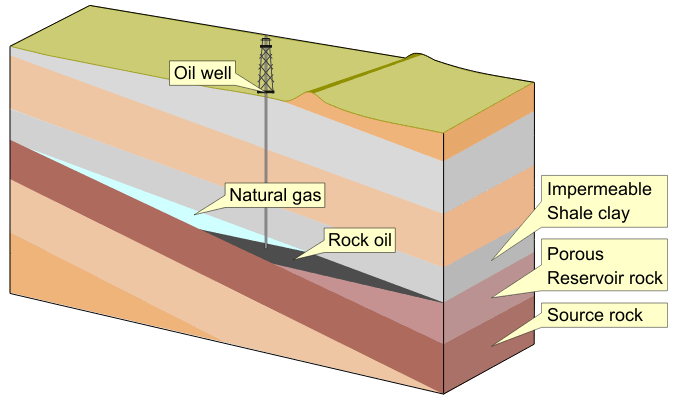
Draw a simple diagram to show the layer of natural gas and petroleum deposit.
Answer
379.8k+ views
Hint: The first four alkanes — methane, ethane, butane, and propane — are known as the four natural gases. An alkane is a hydrocarbon in which each atom is connected by a single bond. Hydrocarbons are chemical substances that only contain carbon and hydrogen atoms. It is generated over millions of years when layers of decomposing plant and animal materials are exposed to tremendous heat and pressure beneath the Earth's surface.
Complete answer:
Natural gas is mostly derived from deep underground petroleum sources. Because gases are lighter than oil, it occurs immediately above the crude oil layer.
Petroleum is a natural liquid found in rock formations. This is made up of a complex mixture of hydrocarbons of various molecular weights, as well as other organic molecules. Some chemical compounds created by petroleum can also be obtained from other fossil fuels.
Natural gas (sometimes known as fossil gas or simply gas) is a naturally occurring hydrocarbon gas mixture primarily composed of methane with different proportions of other higher alkanes, as well as a minor quantity of carbon dioxide, nitrogen, hydrogen sulphide, or helium.

It is generated over millions of years when layers of decomposing plant and animal materials are exposed to tremendous heat and pressure beneath the Earth's surface. The energy that the plants got from the sun is stored in the gas in the form of chemical bonds. Natural gas is classified as a fossil fuel.
Petroleum, often known as crude oil or oil, is a naturally occurring yellowish-black liquid found deep beneath the Earth's surface in geological formations. It is frequently processed into a variety of fuels.
Note:
Its combustion, as a fossil fuel, contributes to harmful emissions, particularly carbon dioxide, one of the most hazardous greenhouse gases. The greenhouse layer in the atmosphere has been altered by human contributions of greenhouse gases, which plays an important role in regulating world temperatures.
Complete answer:
Natural gas is mostly derived from deep underground petroleum sources. Because gases are lighter than oil, it occurs immediately above the crude oil layer.
Petroleum is a natural liquid found in rock formations. This is made up of a complex mixture of hydrocarbons of various molecular weights, as well as other organic molecules. Some chemical compounds created by petroleum can also be obtained from other fossil fuels.
Natural gas (sometimes known as fossil gas or simply gas) is a naturally occurring hydrocarbon gas mixture primarily composed of methane with different proportions of other higher alkanes, as well as a minor quantity of carbon dioxide, nitrogen, hydrogen sulphide, or helium.

It is generated over millions of years when layers of decomposing plant and animal materials are exposed to tremendous heat and pressure beneath the Earth's surface. The energy that the plants got from the sun is stored in the gas in the form of chemical bonds. Natural gas is classified as a fossil fuel.
Petroleum, often known as crude oil or oil, is a naturally occurring yellowish-black liquid found deep beneath the Earth's surface in geological formations. It is frequently processed into a variety of fuels.
Note:
Its combustion, as a fossil fuel, contributes to harmful emissions, particularly carbon dioxide, one of the most hazardous greenhouse gases. The greenhouse layer in the atmosphere has been altered by human contributions of greenhouse gases, which plays an important role in regulating world temperatures.
Recently Updated Pages
Master Class 9 General Knowledge: Engaging Questions & Answers for Success

Master Class 9 English: Engaging Questions & Answers for Success

Master Class 9 Science: Engaging Questions & Answers for Success

Master Class 9 Social Science: Engaging Questions & Answers for Success

Master Class 9 Maths: Engaging Questions & Answers for Success

Class 9 Question and Answer - Your Ultimate Solutions Guide

Trending doubts
State and prove Bernoullis theorem class 11 physics CBSE

What are Quantum numbers Explain the quantum number class 11 chemistry CBSE

Who built the Grand Trunk Road AChandragupta Maurya class 11 social science CBSE

1 ton equals to A 100 kg B 1000 kg C 10 kg D 10000 class 11 physics CBSE

State the laws of reflection of light

One Metric ton is equal to kg A 10000 B 1000 C 100 class 11 physics CBSE




